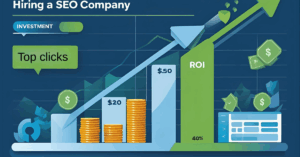On-Page SEO
A Comprehensive Guide to Higher Rankings and Organic Traffic
What Is On-Page SEO?
On-Page SEO, also known as on-site SEO, encompasses all the optimization techniques you can implement directly on your website to improve its search engine ranking and organic traffic potential. This involves optimizing various page elements like content, structure, and technical aspects to signal relevance and value to both search engines and human visitors.
Think of on-page SEO as the foundation of your website’s search engine visibility. By meticulously crafting and optimizing your web pages, you provide search engines with the necessary clues to understand the content, context, and value your website offers to specific search queries. This, in turn, increases your chances of ranking higher and attracting qualified organic traffic from potential customers or readers.

In the ever-evolving world of digital marketing, search engine optimization (SEO) remains an essential strategy for driving consistent organic traffic to your website. While often associated with complex algorithms and mysterious ranking factors, SEO can be broken down into two fundamental aspects: On-page and off-page SEO.
This article delves into the intricacies of on-page SEO, exploring its various elements, best practices, and practical examples to help you optimize your web pages for search engine visibility and user experience.
Key Elements of Effective On-Page SEO
On-page SEO encompasses a diverse range of elements, each playing a crucial role in influencing your search engine ranking. Here are some of the most critical aspects to consider:
1. Content: The Cornerstone of On Page SEO
High-Quality, Informative Content: Search engines prioritize websites that offer valuable and informative content that addresses the specific needs and questions of their users. Focus on creating well-researched, engaging, and original content that resonates with your target audience.
Keyword Optimization: While keyword stuffing is no longer a viable strategy, strategically incorporating relevant keywords throughout your content (titles, headings, body text) helps search engines understand the topic and context of your page.
Content Structure and Readability: Structure your content logically using clear headings, subheadings, and bullet points to enhance readability and user experience. Aim for concise sentences and paragraphs to improve user engagement.Freshness and Updates: Regularly update your content with new information, insights, or perspectives to demonstrate continued relevance and expertise in your field.
Example: Imagine you own a travel blog and aim to rank higher for the search term “best hiking trails in Yosemite National Park.” Your content strategy should involve creating detailed blog posts about various hiking trails within the park, including: Compelling titles like “5 Must-Hike Trails for Breathtaking Views in Yosemite”
Informative descriptions covering difficulty levels, scenic highlights, and estimated durations.
High-quality images showcasing the beauty of the trails.
Regularly updating content with current information on trail conditions, closures, or new discoveries.
Freshness and Updates: Regularly update your content with new information, insights, or perspectives to demonstrate continued relevance and expertise in your field.
Example: Imagine you own a travel blog and aim to rank higher for the search term “best hiking trails in Yosemite National Park.” Your content strategy should involve creating detailed blog posts about various hiking trails within the park, including:
Compelling titles like “5 Must-Hike Trails for Breathtaking Views in Yosemite”
Informative descriptions covering difficulty levels, scenic highlights, and estimated durations.
High-quality images showcasing the beauty of the trails.
Regularly updating content with current information on trail conditions, closures, or new discoveries
2. Technical SEO: The Invisible Backbone
On-page SEO goes beyond visible content, encompassing the technical aspects that ensure your website’s functionality and search engine crawlability. Here are some key technical SEO factors:
Page Speed and Mobile Friendliness: Search engines prioritize websites that load quickly and offer a seamless user experience on all devices, including mobile phones. Ensure your website has optimized page speed and responsive design for optimal performance.
Website Structure and Navigation: A clear and logical website structure with intuitive navigation allows search engines and users to easily discover and access your content.
Schema Markup: Implementing schema markup provides search engines with additional context about your content, potentially enhancing your search result snippets with rich information like star ratings or event details.
3. Title tags, meta descriptions, and headings:
These elements act as signposts, guiding both search engines and users towards understanding your content’s value and purpose.
Title Tags: Craft clear, concise, and keyword-rich title tags that accurately reflect the content of your page. They appear as the clickable headline in search engine results pages (SERPs).
Meta Descriptions: Write compelling meta descriptions that provide a brief summary of your page content. While not a direct ranking factor, they can significantly impact click-through rates (CTRs) from SERPs.
Headings: Utilize clear and descriptive headings (H1, H2, H3) to structure your content, improve readability, and indicate the hierarchy of information on your page.
Example: For your Yosemite hiking trails blog post, the title tag could be “Top 5 Hiking Trails in Yosemite National Park: Breathtaking Views Await,” while the meta description might entice users with “Explore the diverse landscapes of Yosemite with our guide to the park’s 5 most scenic hiking trails, suitable for all skill levels.”
4. Internal Linking:
What is an internal link?
An internal link is a type of hyperlink on a web page to another page or resource, such as an image or document, on the same website or domain.It is the opposite of an external link, a link that directs a user to content that is outside its domain.
Strategic use of internal links within your website connects related pages, improves website navigation for both users and search engines, and helps distribute link equity throughout your site.
Link relevant pages within your website using descriptive anchor text that accurately reflects the linked page’s content.
Avoid excessive linking or using the same anchor text for multiple links.
Example: In your Yosemite hiking trails blog, you could link to a separate page detailing “Essential Gear for Hiking in Yosemite” using an anchor text like “hiking gear guide” within the relevant section of your content.
5. Image Optimization:
Images can enhance content engagement and user experience, but they can also impact SEO if not optimized properly.
Use descriptive and keyword-rich file names and alt text for your images, helping search engines understand their relevance to your content.
Optimize image file sizes to ensure fast page loading speeds.
Example: Instead of naming an image “IMG_001.jpg,” rename it to “yosemite-half-dome-trail.jpg” and add alt text like “Hikers enjoying the view from Half Dome in Yosemite National Park.”
How do optimize website images for SEO?
Additional On-Page SEO Considerations
Mobile-First Indexing: With the majority of searches now conducted on mobile devices, prioritize mobile-friendliness and ensure your website offers an optimal user experience on all screen sizes.
Structured Data: Consider implementing structured data markup to provide search engines with additional context about your content, potentially leading to richer search result snippets.
Optimize image file sizes to ensure fast page loading speeds.
User Engagement Metrics: While not a direct ranking factor, user engagement metrics like dwell time, bounce rate, and click-through rate can indirectly influence search engine rankings.
Conclusion: On-Page SEO: A Continuous Journey
On-page SEO is an ongoing process, not a one-time fix. By consistently implementing the best practices and strategies outlined above, you can create a solid foundation for improved search engine visibility and organic traffic. Remember, search engine algorithms are constantly evolving, so stay updated on the latest trends and best practices to maintain your website’s search engine optimization efforts.
Additional Tips:
Utilize SEO tools and resources to assist you with keyword research, competitor analysis, and page optimization tasks.
Conduct regular website audits to identify areas for improvement and ensure your website remains technically sound.
Monitor your website’s performance through analytics tools to track the impact of your on-page SEO efforts and make data-driven adjustments as needed.
By mastering on-page SEO and staying dedicated to continuous optimization, you can unlock the full potential of your website, attract qualified organic traffic, and achieve your online marketing goals.


